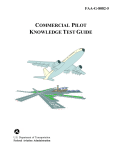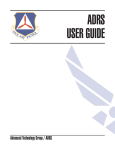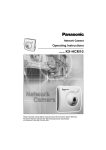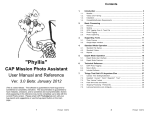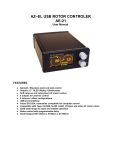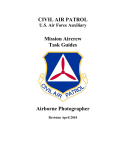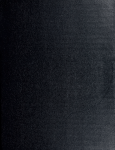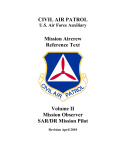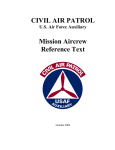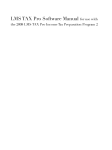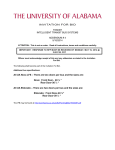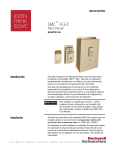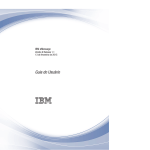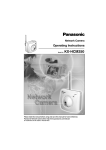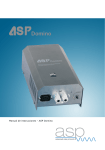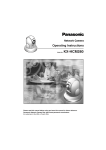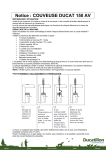Download guide for squadron maintenance officers
Transcript
SDWG Guide 66-2
1 June 2012
GUIDE FOR SQUADRON
MAINTENANCE OFFICERS
Third Edition
CONTENTS
I.
THE BIG PICTURE
-- Where you fit in
II.
GOVERNING DIRECTIVES
-- The sources which tell you what has to be done
III.
RESPONSIBILITIES
-- What you are expected to do
IV.
AUTHORITIES
-- How CAP empowers you to meet your responsibilities
V.
TERMS AND EXPLANATIONS
-- Learning the languages of Maintenance and Finance
VI.
AIRCRAFT MAINTENANCE FUNDS
-- Where the money comes from and where the money goes
VII.
REPORTS AND FORMS
-- This is where you tell the world how good you are
VIII.
WORKING WITH OTHERS
-- You can’t do this job in a vacuum
IX.
ELECTRONIC REPORTING
-- CAP’s voracious appetite for data
X.
QUICK REFERENCE GUIDES (NEW)
-- What specific tasks to do and how to get them done
BURLEIGH J. PUTNAM, Lt Col, CAP
SDWG Maintenance Officer
Comment [WU1]:
Comment [WU2]: John Seten
John Seten, MAJ CAP SD Director of Operations
E. W. Filler, CPT CAP SD Aircraft Maintenance Officer
1
Supersedes SDWGG 66-2 dated 17 Aug 03
SDWG Guide 66-2
1 June 2012
This page intentionally left blank
2
Supersedes SDWGG 66-2 dated 17 Aug 03
SDWG Guide 66-2
I.
1 June 2012
THE BIG PICTURE
1. CAP units have been equipped with aircraft to conduct specific duties
such as airborne search, transport, and flight orientation. To carry out
these duties Civil Air Patrol, Inc. is authorized by the U.S. Air Force to
operate and maintain a fleet of 535 powered airplanes, plus 62 gliders.
“Civil Air Patrol, Inc.” is the registered owner of these aircraft.
2. These aircraft are allocated to geographic regions. In turn, each region
allocates those aircraft to its subordinate wings. The allocating process
follows a methodical assessment of needs called the “Corporate Aircraft
Distribution” formula.
a. At present, South Dakota Wing (SDWG) operates 6 powered
airplanes and four gliders. These aircraft are, in turn, allocated to the
flying squadrons by the wing DO according to needs keeping in mind
the need to maintain operational readiness at all times. The Wing DO
then decides (1) at which airfields a corporate aircraft can be employed
most advantageously, (2) utilized most effectively, and (3) supported
most efficiently. And that’s how your squadron wound up with a
corporate aircraft to operate – and maintain.
b. A “gaining” unit typically receives permanent assignment of a
corporate aircraft. At that point, the responsibilities fall on that unit to (1)
employ the aircraft on as many USAF and/or CAP missions as it can with
the aircrews it has; (2) fly the aircraft as much as possible; (3) keep the
aircraft in a safe, operable condition; and (4) generate enough revenue
(from flight charges) to pay for the aircraft’s upkeep.
3. At the National Headquarters level CAP/MXA (Fleet Management—
Aircraft) is responsible to make all this happen. The individual charged
with day-to-day management of the corporate aircraft fleet is designated
the Aircraft Manager.
a. In turn, each region designates a counterpart to oversee the utilization
and upkeep of its allocated fleet. In turn, each wing relies on a
maintenance officer to perform the same management of its allocated
fleet.
b. CAPR 20-1, Organization of Civil Air Patrol, provides the organization
structure in which a wing maintenance officer performs these duties.
CAPR 20-1 also gives each wing the option of aligning their maintenance
officer under the Operations or Logistics staff.
c. Within SDWG the Maintenance Officer works for the Director of
Operations (SDWG/DO) and is therefore referred to by the office
symbol “DOAM”.
3
SDWG Guide 66-2
1 June 2012
4. CAPR 20-1 further details where the maintenance officer fits in the
squadron-level organization and lists the primary responsibilities of this
person.
a. Although most of your instructions, technical advice, queries for
information, and assistance may come from SDWG/DOAM, you do not
work for the Wing Maintenance Officer. That person is not in your chain
of command. You work for your squadron operations or logistics officer,
depending on how your squadron commander aligns the function of
aircraft maintenance within your unit.
b. Besides performing duties governed by CAP regulations, you must
manage a maintenance effort which complies with Federal Aviation
Regulations (FARs). CAP regulations on matters of flying and aircraft
maintenance must also conform to FARs… so you will not find yourself
“caught in the middle” of conflicting directives.
c. You are also the interface between CAP and all the maintenance
vendors through whom you must deal to keep your aircraft flying. CAP
regulations allow units latitude to perform this vital function. A list of
current vendors used by SD CAP are listed in Quick Reference #.
5. So that’s where you fit into the scheme for CAP’s management of its
aircraft fleet: at the bottom of the totem pole. But the squadron-level
maintenance officer position is where “the rubber meets the road”.
a. In this position, you have many responsibilities to meet for the upkeep
and safeguarding of a very expensive corporate asset.
b. At the same time you have significant authority to determine when and
where to conduct minor maintenance on your aircraft.
III.
RESPONSIBILITIES
A. What exactly is a squadron-level maintenance officer supposed to do? And
how do you get such tasks done? Well… the basic responsibilities are laid out in
CAPR 20-1, Part III (Senior Member Position Descriptions) Quick Reference #X.
Your position description says an Aircraft Maintenance Officer “exercises staff
supervision and coordination of all aircraft maintenance. They shall:
Make recommendations to the commander for the
improvement of the maintenance program
Ensure that aircraft are painted and identified in
accordance with current directives
Ensure that aircraft are maintained in an airworthy
condition in accordance with FAA requirements”
(Pretty vague, huh?)
SDWG Guide 66-2
1 June 2012
B. As you plow through the various governing directives (see Section II) you
can start swallowing this job in smaller bites…
1. You have to safeguard and protect your assigned corporate aircraft.
You must make sure it’s parked on a spot which meets CAPR
66-1(Quick Reference #X) minimum anchoring requirements;
then make sure your unit uses approved tiedown devices and
chocks
You must make sure it has the covers required by CAPR 66-1;
and that the covers are both serviceable and presentable. Quick
Reference #X
You must make sure it has an acceptable throttle
quadrant/avionics lock installed to deter theft of high-value
avionics (NOTE: CAP hasn’t yet come up with a suitable
protection for the “glass cockpit” displays… such aircraft only
require a suitable gust lock/throttle quadrant lock)
You must make sure the door locks work properly so onboard
stuff doesn’t get pilfered easily; and that there are controls on
who gets issued keys to the aircraft
You need to periodically inventory the stuff aboard your aircraft
to make sure it hasn’t disappeared… or doesn’t need repair,
replacement, or replenishment and ensure equipment is
functional.
2. You have to plan scheduled maintenance actions and de-conflict these
actions from known flying requirements.
“Scheduled” maintenance includes oil changes, 100hour and annual inspections, “calendar” inspections,
washes, corrosion preventive treatments, pitotstatic/altimeter/transponder recertifications, and ELT
battery replacements… for example
You may also get enough advance notice to plan
refurbishments, painting, equipment alterations, or
equipment upgrades
3. You have to react to unscheduled (unexpected) maintenance
needs and get repairs accomplished as promptly as time, availability of
mechanics and shops, and availability of facilities allow. SD Wing
DOAM will facilitate
Recent CAP policy changes now require units to only
use maintenance vendors (FBOs or individual
mechanics) which carry sufficient liability insurance
coverage
SDWG/DOAM is responsible to verify your
choice of maintenance vendor carries
adequate, current liability insurance coverage
4. You have to purchase maintenance services, performed by individual
aircraft maintenance technicians (AMTs), fixed-base operators (FBOs),
or certificated repair stations (shops), in order to keep your aircraft
airworthy to standards established by FARs.
-- You may require repairs, alterations, installations or removals,
15
SDWG Guide 66-2
1 June 2012
inspections, functional tests, cleaning or corrosion treatments,
or troubleshooting
-- This means you also have to find the right specialist to do the
job
-- This means you also need to get the right facility for the job
5. You may have to purchase the parts, components, kits, or materials
needed by the mechanic/shop to keep your aircraft airworthy.
6. When a maintenance task is completed you must make sure all
maintenance actions are correctly and completely documented. This is
a critical task.
(A truism in the world of aircraft maintenance is “If it ain’t documented… it
didn’t happen!”)
If you request maintenance from a mechanic the
completed actions must be entered in appropriate
maintenance logbooks. (Usually an aircraft will have
separate logbooks for airframe, powerplant, propeller,
and radio/avionics.) Log books are kept in the cargo
hold.
If the task involves new or replaced equipment, or
modification, you must also make sure the unit
receives appropriate FAA- required documents from
the manufacturer or repair station… such as
“airworthiness” certificates for manufactured parts;
“serviceable” tags for overhauled/repaired parts; or
“major repair/alteration” approval documents.
(You have help. FAR 43.9 addresses the “content, form, and disposition
of” such maintenance entries. FAR 43, Appendix D further describes the
scope and detail of items to be included in annual and 100-hour
inspections. For instance…)
Oil changes must cite the authority; the oil type and
quantity used; and any other actions taken related to
the event (such as oil filter replaced, oil screen
cleaned, oil sample taken…).
Inspections must be performed “in accordance with” a cited
FAR or manufacturer’s publication.
Time-changes (such as ELT batteries) must document
actions taken; specify the make/model/part number of
the new item; and list the item’s expiration date or nextdue event time.
Airworthiness Directives or Service Bulletins must
cite the designation of the AD or SB; the method of
accomplishment; and the results if it’s an inspection
action. If it’s a recurring AD or SB the entry must also
show the date or tachometer reading when next due.
Parts or appliance replacements must cite the specific
actions taken; cite the technical data used; specify
make/model/part
16
SDWG Guide 66-2
2011
1 November
number/serial number to positively identify the replacement
component; and identify any functional or operational
checks due before the aircraft can be returned to service.
Repair actions must identify what was repaired and by what
method the repair was accomplished. Functional checks (if
required) must be documented, with their results. Any parts or
hardware used must be identified (although if the list is lengthy
they may be documented on the shop’s/mechanic’s work order
or invoice, and the work order just referenced in the logbook
entry).
All maintenance entries must include the date and tachometer
reading – or total time airframe (TTAF) when the action was
taken. Most (but not all) actions require an entry that the aircraft
(… or prop, or engine) was returned to service. All entries
require the signature of the certificated mechanic (AMT) or
inspector (IA) or repair station employee who is authorized by
FAR 43 to make such entries.
7. You may also have to purchase parts, equipment, tools, materials,
and supplies needed by your squadron to keep your aircraft clean
and presentable for CAP’s “customers”.
8. You may also have to collect revenues from “nonreimbursed”
flying; deposit such income to the Wing’s Aircraft Account; and
request payment for your vendors. These duties may be allocated
to others in your squadron at the discretion of the commander.
See Section VI for more details.
9. You have to control maintenance-related costs to insure your
unit’s Aircraft Account doesn’t run out of money. At the very
least…
decide what maintenance must be done now to keep the
aircraft flying
decide what maintenance should be done, at a later
time, to keep the aircraft flying
decide what maintenance would be nice to do…
time and money permitting
decide what maintenance may cost more
than the improvements (or
enhancements) are worth
10. You have to collect a lot of information and data to submit several
periodic reports to higher headquarters; or to update internet databases.
See Section IX for more details.
11. From time to time you may get tasked to collect data, change a
procedure, assess your aircraft’s paint or interior condition, verify
17
SDWG Guide 66-2
1 June 2012
compliance with an AD or SB, or otherwise scurry around to get
answers for someone else.
12. You should periodically examine how well you are doing. Try the
Subordinate Unit Inspection Guide, Tab C-4, Aircraft Management. It’s
available to download from the CAP/IG web page at
http://level2.cap.gov/visitors/programs/inspector_general/ig_inspections
.cfm ; then click on the “SUI Guide” hypertext link.
IV. AUTHORITIES
A. A founding principal of effective management is that AUTHORITY MUST BE
COMMENSURATE WITH RESPONSIBILITY.
1. As a squadron-level maintenance officer, CAPR 20-1 delegates the
authorities you need to meet assigned responsibilities.
Through your unit commander you will be empowered to
“ground’ the corporate aircraft should you determine its
condition warrants being removed from service
You are further designated the authority to report your aircraft
“operational” when it’s returned to service by FAAcertificated mechanics. The SDWG Supplement to CAPR
66-1 identifies you as the person who will report changes to
the status of your aircraft to higher headquarters.
Your signature is required on some recurring reports, to
signify the report information is legitimate.
Since you are responsible for meeting the unit’s
maintenance-related expenses, you also are the focal point
for determining the hourly flight charges to be collected for
“nonreimbursed” flying with your aircraft.
You will inherit the keys for your assigned aircraft avionics
lock, hangar doors (if applicable), and any equipment the
unit possesses for support of the aircraft. You will likely
become the issuer of keys to new aircrew members.
2. You will also discover you have broad latitude to decide what, when,
where, and how to get maintenance done… by default. (Hardly anyone
else in your squadron wants this job; nor understands what must be
done; nor how to get it done.)
3. As you gain understanding of the CAP aircraft maintenance program
you will gain “expertise”. And with “expertise” comes deferral to your
decisions (on matters of aircraft maintenance and often aircraft
finances). Learn your job well, become successful at it, and you will
discover you now have even more latitude to do what’s best for your
aircraft and your squadron.
18
SDWG Guide 66-2
1 June 2012
B. The squadron-level maintenance officer position is a lot of work… but the job
can be exhilarating!
V.
TERMS AND EXPLANATIONS
To perform maintenance successfully and maximize your unit’s aircraft
availability, you must know the languages of “maintenance” and “finance”. You
don’t have to be fluent… but you do need familiarity with a certain minimum
vocabulary of terms.
1. Aircraft Status: DOWN vs UP. These are slang terms. They refer to an
aircraft’s availability – either out of service (“down” for maintenance) or
serviceable (“up” for flying). Note that an aircraft must be serviceable to be
“up”; but can be either serviceable or unserviceable when it’s taken “down”
to perform maintenance or inspections or alterations or refurbishments.
2. MAINTENANCE vs PREVENTIVE MAINTENANCE. These terms come
from FAR Part 43 and are used to establish who is authorized to perform
tasks under each of these definitions. The significance for a unit
maintenance officer is that a certificated mechanic or repair station is
required to perform “maintenance”; while an owner/operator (that’s you)
can perform “preventive maintenance” as listed in FAR Part 43, Appendix
A. (At least, those tasks now approved by NHQ CAP policy memo.)
3. INSPECTING, ALTERING, MODIFYING, REPAIRING, REBUILDING,
SERVICING, CLEANING, TESTING. These are all specific kinds of tasks
under the general description of “maintenance”. FAR Part 43, Appendix A
establishes which tasks, on which parts of an aircraft, may be performed
by an owner/operator.
4. MAINTENANCE LOGBOOKS, WORK ORDERS, INVOICES,
CONDITION TAGS, EQUIPMENT LISTS. All these documents serve to
record some aspect of maintenance performed on your aircraft or its
components. Thorough records-keeping is absolutely essential.
5. AIRWORTHINESS DIRECTIVES vs SERVICE BULLETINS.
“Airworthiness Directives” (ADs) are issued by the FAA; while “Service
Bulletins” (SBs) are issued by the manufacturer of the component affected.
Both are designed to alert the aircraft owner/operator to a change… made
either to the component or to the way it’s operated, inspected, repaired,
serviced, or tested.
a. ADs are normally issued to improve safety-of-flight conditions;
and require mandatory compliance. The FAA also issues
Special Airworthiness Information Bulletins and Unapproved
19
SDWG Guide 66-2
1 June 2012
Parts Notifications… which are not mandatory compliance.
b. SBs may be issued by a manufacturer to correct a deficiency in the
part or offer an enhancement to the original part. They will typically
label their SB as either “optional” or “mandatory”. Since CAP
operates its aircraft under FAR Part 91 rules SBs are not
considered mandatory by the FAA… so they will usually declare
that the old (or unmodified, or uninspected) part will become
“unserviceable” after a specified period of time.
c. Within CAP, the Aircraft Manager (described later on) determines
which “mandatory” SBs CAP will choose to comply with; and
notifies wings to accomplish such SBs.
6. CALENDER vs TIME inspections. FAA terminology. Corporate
aircraft require several recurring inspections. The interval between
inspections is measured either by elapsed days/months (“calendar”
intervals) or elapsed engine tachometer readings (“time” intervals)…
not Hobbs meter readings.
7. STC vs STA vs PMA vs Unapproved Part vs TSO. These are also
FAA terms.
a. “Supplemental Type Certificates” (STCs) are sought from the
FAA by manufacturers or repair stations or even individuals so they
may modify or alter or enhance an aircraft/engine/appliance to
some new configuration with new operating parameters acceptable
to the FAA and useable on the original aircraft or engine or
appliance. The “STC holder” owns the technical data for an STC
as proprietary information. (If CAP wants to install an STC, they
have to purchase it from the STC holder.)
b. “Supplemental Type Approvals” (STAs) are sought from the
FAA by manufacturers for spiffy new components they have
devised and want to sell to you for your aircraft.
c. “Parts Manufacturer Approvals” (PMAs) are sought by other
parts manufacturers from the original manufacturer so they may
continue to sell the same part to customers. “PMA’d” parts insure
the item meets the same technical specifications and requirements
that the original part did (when it was approved by the FAA).
d. An “unapproved part” is any item for which its manufacture or
repair cannot be traced to its source of production or source of
repair, through documentation approved by the FAA.
e. A “Technical Standard Order” (TSO’d) component does not
require an STC because it meets a set of stringent design,
manufacture, and performance “standards” established by the FAA
for several classes of components to insure such items meet all
airworthiness standards detailed elsewhere among FARs. (Most
avionics components, tires, batteries, restraint harnesses --as
examples -- are manufactured to conform to a TSO.)
20
SDWG Guide 66-2
1 June 2012
8. MAJOR maintenance vs MINOR maintenance. These are CAP-coined
terms, used to establish the source of payment. (The terms differ
from FAR Part 43 uses of “major” and “minor” repairs.)
a. “MAJOR maintenance” defines a specific list of maintenance
tasks performed on specific kinds of aircraft parts, airframes,
engines, or propellers. Maintenance tasks which fall under
CAP’s definition are eligible for payment from USAF
appropriated funds… rather than out of CAP revenues.
These tasks are spelled out in CAPR 66-1.
b. “MINOR maintenance” – by default – covers every other
maintenance task performed on aircraft.
9. REIMBURSABLE vs NONREIMBURSABLE maintenance costs. CAPimposed definitions. Used to identify which kinds of maintenancerelated costs may be reimbursed or paid directly from the wing’s
AIRCRAFT ACCOUNT as a “minor maintenance” expense; or
shouldered by the individual unit from their GENERAL account or
SQUADRON AIRCRAFT account because the cost is not eligible for
“minor maintenance” funds. (The use of wing “minor maintenance”
funds are spelled out – not too clearly – in CAPR 173-3.)
10. REIMBURSED vs NONREIMBURSED flying. More CAP definitions,
used to identify the source of revenue when using corporate aircraft.
a. “Reimbursed” flying means a recognized agency with an
approved letter of agreement (LOA) or memorandum of
understanding (MOU) with CAP, will “rent” the corporate
aircraft and pay for its flight hours (and some related
expenses) at rates set by NHQ CAP.
b. “Nonreimbursed” flying refers to all other uses of a corporate
aircraft. Since all Hobbs meter time must be expensed by the
unit (that is, accounted for) it falls on the unit which maintains
the aircraft to collect payments generated by “nonreimbursed”
flying, at rates which the unit is authorized to establish.
11. MISSION SYMBOLS vs MISSION NUMBERS. Although this is not
directly a “maintenance” issue, it always causes confusion among
those who must pay for the use of a corporate aircraft.
a. A “mission symbol” is an accounting mechanism for CAP to track
and tabulate how its corporate aircraft are being employed.
“Mission type” – “A”, “B”, “C”, or “L” – also define who pays for the
hours. Mission symbols are found in CAPR 60-1, Atch 10.
b. A “mission number” is assigned for a one-time specific use of
corporate aircraft in support of USAF or CAP flight taskings; and
is another accounting mechanism. It also is used to insure the
plane and aircrew are protected under the Federal Tort Claims
21
SDWG Guide 66-1
1 June 2012
Act; and aircrew members are eligible for state Workers
Compensation.
CAUTION: Just because a flight has a mission number assigned does not
guarantee the flight is “reimbursed” flying i.e., that someone other than the pilot
member is paying for the flight hours or avgas. Better be sure.
10. I just have to throw in this acronym… SOAP is a Spectrometric Oil
Analysis Program. The trace-metal contents of your engine’s oil can be
an early indicator of unusual or excessive component wear… and
therefore a precursor to an engine failure.
a. SOAP sampling is required at each oil change during the life of
your plane’s engine.
b. At squadron level, you must retain the analysis results with your
engine’s maintenance records.
VI. AIRCRAFT MAINTENANCE FUNDS
A. As a consequence of CAP’s pursuit of an “unqualified” audit, recent changes
to CAPR 173-series regulations resulted in consolidation of former squadronlevel aircraft funds from squadron control to wing control under “Central Banking”.
SDWG now pays all maintenance-related expenses from a consolidated winglevel Aircraft Account.
1. Squadrons may initiate a requirement for funds by generating an
Aircraft Purchase Order (ACPO); SDWG/DOAM then validates all
requests for payment.
2. “Reimbursed” flight revenue is collected from agencies by NHQ CAP
and is then paid to each wing. This income remains ‘invisible’ to
squadrons.
3. “Nonreimbursed” flight revenue must be collected, deposited, and
reported by the squadron which is permanently assigned the
corporate aircraft.
B. South Dakota Wing must account for all revenues generated by each
corporate tail number. The squadron maintenance officer is often the focal
point for both collecting aircraft revenues and obligating maintenance-related
expenses. (But you should rely on your squadron’s finance officer to help with
these tasks.)
C. Your understanding of the way money moves within CAP is important. You
need to learn about:
• CAP’s various sources of money
• Collecting revenues
22
SDWG Guide 66-2
1 June 2012
• Paying expenses
Once you understand these mechanisms, you can then see how your
squadron’s flying hours, “flight charges”, and nonreimbursable costs relate to
each other. (And how you can manage them so to keep money in the bank.)
D. However… you won’t find the answers in this guide. The management of
aircraft-related CAP money is important enough to merit a separate publication,
Guide to CAP’s Aircraft Maintenance Funds. It’s a companion to this guide; and
is available on the SDWG Publications web page as SDWGG 66-3. Quick
Reference #X
(See Figure 5, The Aircraft Cycle to better understand how missions
generate flight hours; flight hours beget revenue; revenue pays for
maintenance; maintenance produces aircraft availability; and availability
allows us to participate in more missions.)
23
SDWG Guide 66-2
1 June 2012
24
SDWG Guide 66-2
1 June 2012
VII. REPORTS AND FORMS
A. The following forms are used to report information or data which involve a
corporate aircraft:
1. CAP Form 18(E), Operations Monthly Activity Report
use is directed by CAPR 60-1, para 2-7
used to report monthly corporate aircraft flying hours by tail
number
“template” form; submitted via internet through a NHQ CAP
web site
each individual maintenance officer creates their own user
ID and password; SDWG/DOAM assigns reporting
permissions
several products (reports) are available for squadron use
2. CAP Form 26, Safety Improvement or Hazard Report
use is explained in CAPR 62-1, para 2.c
general-use “template” form is available on-line; used to
report hazardous operations or dangerous conditions
may be submitted by anyone, anytime, to lowest level
where the problem can be addressed or corrected
may be handwritten; submitter doesn’t have to identify them
self
3. CAP Form 37A, Shipping & Receiving Document for Aircraft
use is explained in CAPR 67-1, Chapter 5
used by SDWG/DOAM and units to account for corporate
aircraft transfers; also to list installed equipment items
updated any time new equipment is installed or removed
unit commander or supply officer must sign
4. CAP Form 71, Aircraft Inspection Checklist (Quick Reference #X)
use is explained in CAPR 66-1, para 8.f
used at all echelons to document current condition of
corporate aircraft as well as status of its maintenance
records, inspections, and compliance with CAP-directed
requirements
5. CAP Form 78, Mishap Report Form
• use is directed by CAPR 62-2, para 5
• used to report any kind of incident/accident
• now an on-line “template” form which goes directly to NHQ CAP
• typically generated by the unit safety officer; has 48-hour
suspense
6. CAP Form 79, Mishap Investigation Form
use is directed by CAPR 62-2, para 6
documents any investigation and recommendations for
corrective actions
form is automatically generated as part of the Form 78
generated by the investigating officer; submitted via internet
25
SDWG Guide 66-2
1 June 2012
7. CAP Form 99, Flight Release Log
use is detailed in CAPR 60-1, Chapter 4
a monthly summary of flight releases; now generated
automatically via internet when a flying mission is completed
in WMIRS (described in Section IX: Electronic Reporting)
8. CAP Form 108, Payment/Reimbursement Document for
Aviation/Automotive/Miscellaneous Expenses
use is detailed in CAPR 173-3, para 2
used to document reimbursable expenses related to a
corporate aircraft used on ‘reimbursed’ missions
now generated automatically via internet when a flying
mission is completed in WMIRS
claims may be submitted by either individual members or units
9. CAP Form 132, HSI Claim Form
use is detailed in CAPR 900-6, para 6
used to claim expenses payable by NHQ CAP from ‘major
maintenance’ funds or from a member’s insurance carrier, for
repairs as a result of accidental loss or damage to corporate
aircraft
filled out by SDWG/DOAM and submitted to CAP/LG for
approval
10. CAP Form 176, Aircraft Major Maintenance Reimbursement Request
use is explained in CAPR 66-1, para 12
a “template” form, filled out and submitted by
SDWG/DOAM to request appropriated funds be used to
purchase “major maintenance” repairs or upgrades for a
select list of tasks
must be submitted and approved by CAP/MXA before a
unit may purchase parts or obligate work
12. Aircraft Information File (AIF) binder.
NHQ CAP instituted nationwide “standardized” content for this
binder. CAPR 60-1, para 2-14 requires an AIF binder be carried
aboard each corporate aircraft on every flight.
-- The content for the tabs of this binder can be viewed at
http://www.cap.gov/visitors/members/operations/index.cfm?nodeID=68
50&audienceID=4 . Quick Reference #X.
-- Historically in this Wing, the chore of maintaining the content of the
plane’s AIF binder has fallen on the squadron maintenance officer –
even though this duty is not tasked specifically in any regulation or
policy memo…
B. Within South Dakota Wing, the following forms are in use:
1. SDWG Form 11, Request for Payment
26
SDWG Guide 66-2
1 June 2012
use is explained in SDWG Policy Letter #21, Wing Financial
Policy
“template” form available; may also be filled out by hand
submitted for payment of a wide variety of unit expenses, to
include aircraft-related costs not eligible for payment from the
wing’s Aircraft Account as “minor maintenance”
“request” may be signed by anyone; but must be approved by
unit finance committee member or commander depending on
amount of payment
2. SDWG Form 52, Corporate Aircraft Flight Charges Questionnaire
use is explained in SDWGG 11-1, Chapter 11; and in the SDWG
Sup 1 to CAPR 66-1, para 14.b.4)
used to report current flight hour charges which each squadron
establishes for use of corporate aircraft on “nonreimbursed” flights
available as a “template” form on the SDWG Publications web page
submitted any time the unit changes its rates
must be signed by either the unit finance officer or commander
3. SDWG Form 66, Corporate Aircraft Storage and Mooring Report
use is detailed in SDWGG 11-1, Chapter 11 and in the SDWG Sup
1 to CAPR 66-1, para 15
used to verify compliance with CAPR 66-1 mooring requirements
submitted whenever a plane’s parking arrangement or location is
permanently changed
available as a “template” form on the SDWG Publications web page
must be signed by either the unit operations officer or commander
4. SDWG Form 125G, Glider Preflight Safety Inspection Guide
use is detailed in SDWG Sup 1 to CAPR 62-1, para 13, Atch 5
used by “designated safety representative” at activity sites to
inspect gliders and tow equipment prior to its participation in the
activity
also used by SDWG/DOAM to inspect gliders for condition and
compliance with any CAP-directed requirements
at activity sites, this form is submitted through the activity safety
officer to the activity commander
NOTE: Most formatted reports (forms) may now be transmitted by e-mail as
attached scans or by fax to save time… unless they require attached documents
or originals. Other one-time reports may be tasked from time to time; formats (if
needed) will be provided by the requestor.
NOTE: Ongoing reporting of aircraft status and maintenance events are tracked
by electronic input to selected pages of the on-line Wing Management Utilities
(WMU) described in Section IX.
27
SDWG Guide 66-2
1 June 2012
C. As a maintenance officer, you will also need some familiarity with FAArequired forms and related documents:
1. FAA Form 337, Major Repair and Alteration
issued to evaluate repairs and/or alterations to airframes, engines,
propellers, or appliances
used to certify that such repairs/alterations conform to FAR Part 43
requirements and procedures
must be signed by a certificated mechanic or repair station; and
must describe the work that was done
it is now submitted directly to the FAA national Aircraft Certification
Office rather than to your nearby Flight Standards District Office
(FcaO), by whomever generated the form
the original must be retained permanently with the aircraft’s records
2. FAA Form 8010-4, Malfunction or Defect Report
designed to collect information on any general aviation aircraft
components which fail, or fail to perform as advertised, for any
reason
may be submitted by anyone, to the nearest FcaO
reports can be made via Internet; the template form can be
accessed at http://av-info.faa.gov/icar/ through the “Malfunction or
Defect Submission Form” hypertext link on that page.
3. FAA Form 8050-3, Certificate of Aircraft Registration
a required document; the original must be aboard the aircraft for it to
legally operate in the National Airspace System of the U.S.
issued in the name of Civil Air Patrol, Inc. as “owner”
4. FAA Form 8100-2, Standard Airworthiness Certificate
establishes airworthiness of the make, model, and serial number of
an aircraft; certifies this specific aircraft conforms to its “type
certificate”
specifies which “category(s)” in which this aircraft may be operated
(all CAP powered aircraft are approved for Normal category flight
operations)
a required document; the original must be aboard the aircraft for it to
fly in the National Airspace System
5. FAA Form 8110-2, Supplemental Type Certificate
used by the FAA to certify that new installations or modifications
meet airworthiness requirements and are acceptable changes to the
type certificate for your aircraft
STCs will include installation/modification instructions, needed
drawings, parts lists, operating limitations, applicability, and any
28
SDWG Guide 66-2
1 June 2012
operating instructions needed to supplement the Aircraft Flight
Manual (AFM)
“operating supplements” must be filed as part of the AFM
6.
FAA Form 8120-11, Suspected Unapproved Parts Notification
used to notify the FAA of a suspected unapproved or counterfeit
aircraft component
may be submitted by anyone, directly to the FAA System &
Surveillance Analysis Division
notification can be made via phone or e-mail; or mail/fax a fill-in
form available at http://forms.faa.gov/forms/faa8120-11.pdf
7. FAA Form 8130-3, Airworthiness Approval Tag
filled out by the manufacturer or repair station to certify the part or
appliance you just received was manufactured in accordance with
FAR Part 21 approved parts specifications
also filled out by mechanics or repair stations to certify the part or
appliance was repaired/overhauled in accordance with the
manufacturer’s specifications… and is serviceable
8. FAA: Type Certificate Data Sheet
issued for a specific make, model, and series of airframe, engine, or
propeller
provides design, performance, and operating specifications for the
end item described
additional “notes” may describe permissible operating limitations
and the accessories/parts approved to be used on/with this end item
will also describe all acceptable variants of the basic item, and what
the differences are
D. You also need to know that manufacturers, repair stations, even individual
mechanics, produce forms which implement FAA required records-keeping:
1. Serviceable Tag or Return To Service Tag
a locally-prepared document; has no particular format
used by repair stations or mechanics to certify the part you just
received was repaired, overhauled, refurbished, serviced, or
inspected in accordance with manufacturer’s specifications or with
FAR Part 43 accepted practices and methods… and is serviceable
by convention, these tags are always colored yellow
2. Weight & Balance Certificates
a locally-prepared document; has no particular format
may be prepared by any certificated mechanic, IA (inspectionauthorized mechanic), or repair station
29
SDWG Guide 66-2
1 June 2012
another required document; becomes part of your plane’s AFM; the
aircraft cannot fly without current weight & balance information
being available to the pilot in command
data must be revised whenever installed equipment is added or
removed; or whenever the airframe structure is significantly altered
3. Maintenance Logbooks
logbooks follow no particular format or form, but generally must
allow for aircraft identification, date of entry, tachometer reading at
entry, and space to describe the maintenance actions performed
individual logbooks are normally kept up for the airframe, the engine,
the propeller, and radios/avionics
logbooks become a permanent part of an aircraft’s records
they’re available from several publishers
Are located in the cargo hold.
VIII. WORKING WITH OTHERS
A squadron maintenance officer must interface with many other CAP “players” to
insure aircraft maintenance (a) is de-conflicted from flight operations; (b) required
maintenance gets done; (c) logbooks get documented; (d) reports get submitted;
(e) flight charges get collected; and (f) expenses get paid or reimbursed. This
duty position is also the focal point for conducting aircraft maintenance through
FAA-certificated mechanics, fixed-base operators (FBOs), and repair stations.
A. Working with fellow squadron members:
1. The Commander – Col. Mike Beason
assigns duty positions through personnel actions (CAP Form
2a) or published orders (Personnel Authorization)
signs and releases many reports and forms
issues policies for aircraft scheduling, utilization,
maintenance, flight charge collection
usually the authority to approve funds expenditures from
either the squadron General Account or Aircraft Account
2. Logistics Officer – Col. Mike Beason
• responsible for other squadron assets to include vehicles,
facilities, utilities, and supplies/equipment
• may have oversight for aircraft maintenance and hangar or
tiedown rentals
3. Supply Officer - Vacant
• responsible for upkeep of squadron-possessed equipment
(other than aircraft or aircraft-installed equipment)
30
SDWG Guide 66-2
1 June 2012
• may sign the CAP Form 37A for ‘transfer’ or ‘update’ of
aircraft or aircraft-installed equipment
4. Finance Officer – Col. Mike Beason
• oversees all squadron accounts; must report all
deposited flight charge revenues to Wing
• helps establish aircraft flight hour charges (SDWG Form
52) and may sign the form
5. Operations Officer – Maj. John Seten
normally responsible for aircraft utilization, flight
scheduling, and aircrew qualification
may have oversight for aircraft maintenance
may sign the CAP Form 66 aircraft mooring report
6. Safety Officer – Maj Mark Huntington
• available to assist with mishap reporting
B. Working with Group staff: The Commander
• provides intermediate review of many recurring reports going
to Wing
• has say in allocation of corporate aircraft within the group
• may direct aircraft “sharing” between squadrons
C. Working with Wing staff:
1. The Commander (SDWG/CC) – Col. Mike Beason
has final say on allocation of corporate aircraft within the Wing
negotiates receipt/transfer of corporate aircraft into/out of the
Wing
has signature authority for all real property purchases,
leases, or rental to include aircraft hangar spaces or
tiedown spots
also is the approval authority for any aircraft or aircraftrelated donations to the Wing or individual units
can set policies to better manage the corporate aircraft fleet
approval authority for any Wing-level supplements to parent
CAP
regulations
2. Director of Operations (SDWG/DO) – Maj. John Seten
• has oversight of the aircraft maintenance program
• establishes flying mission priorities (among many responsibilities)
3. Aircraft Maintenance Officer (SDWG/DOAM) – Cpt. E. W. Filler
• focal point for all aircraft-related matters within the Wing
• documents reallocation or reassignment of corporate aircraft
• manages use of the Wing Aircraft Account funds
31
SDWG Guide 66-2
1 June 2012
conducts “periodic” inspection of corporate aircraft
and their maintenance records
selects aircraft for modifications, equipment upgrades,
paint, refurbishment
may solicit vendors for aircraft parts purchases as well as
repairs, alterations, paint or refurb actions
validates all maintenance invoices for payment via the Wing’s
ACPO system
4. Communications Officer (SDWG/DOC) – 1LT Bill Collister
establishes Wing’s Frequency Plan
can arrange to reprogram frequencies in aircraft FM radios
should they be replaced for maintenance reasons
5. Director of Finance (SDWG/FM) – Col. Mike Beason
controls all Wing funds, to include the Aircraft Account
processes all reimbursement requests made via CAP Forms
108; processes all payment requests made via ACPO
control numbers; processes all payment requests made via
SDWG Forms 11
employs a CAP-salaried Bookkeeper to keep track of all
revenue and expenditures; and to generate check
payments
chairs the Wing Finance Committee
6. Director of Logistics (SDWG/LG) – Col. Mike Beason
focal point for non-expendable property (equipment)
reporting and accounting (CAP Forms 37-series documents)
may advise/coordinate with squadrons for matters involving
lease or rental agreements for aircraft tiedowns or hangars,
as well as for squadron facilities
manages the Wing’s vehicle program through the Vehicle
Officer
7. Director of Safety (SDWG/SE) – Maj. Mark Huntington
• has responsibility for safe operating practices with the wing
• involved with all aircraft-related mishap reporting and
investigating
8. Information Services Officer (SDWG/IT) – Cpt. Rick Goeringer
• designs and maintains the South Dakota Wing web site and its
subordinate pages – to include a page for the Aircraft
Maintenance Officer, which carries numerous internet links for
publications and aircraft-related information
• maintains the Wing’s Aircraft Purchase Order System (ACPO)
and enters new vendor data; resolves discrepancies with
individual purchase orders
9. “Incident Commanders”
32
SDWG Guide 66-2
1 June 2012
• will employ individual corporate or member-owned aircraft
for emergency services taskings, based on aircraft status
and mission equipment capabilities
D. Working with National Headquarters (NHQ CAP):
1. Director of Fleet Management (CAP/MX):
• oversees resources formerly assigned to CAP/LG (Aircraft
and
• Vehicles)
• establishes priorities for corporate aircraft purchases and
disposals
• (through the Aircraft Condition Report)
• approval authority for Major Maintenance requests and
Hull Self- Insurance (HSI) claims
• manages CAP’s “contract maintenance” program for aircraft;
solicits maintenance vendor contract proposals; administers
the approved individual vendor contracts; pays the bills
2. Aircraft Manager (CAP/MXA) – Dan Daniels/Paul Skinner
provides day-to-day management of CAP’s corporate aircraft
fleet
arranges release of appropriated funds for aircraft Major
Maintenance expenditures once approved by MX
provides funds for aircraft modernization, avionics or
mission equipment upgrades, equipment alteration,
and aircraft replacements
authorizes avionics component replacements through the
Radio
Exchange Program
can perform parts ordering and shipping; can assist wings
with part number research and pricing
can arrange transport of end items (such as engines and
propellers)
may act as intermediary for factory support of new CAP
equipment or warranty claims
disseminates manufacturer’s Service Bulletins to wings, as
well as Emergency Airworthiness Directives or Unapproved
Parts Notifications
authors CAPR 66-1
NOTE: Visit the MXA web page directly to find out a lot more about “Hot Topics”,
“Airworthiness Directives”, “Mandatory Service Bulletins”, “Recommended
Service Bulletins”, and “Forms & Publications”. These may be accessed at
http://level2.cap.gov/index.cfm?nodeID=5225 .
3. Director of Finance (CAP/FM)
• collects all “reimbursed mission” flight revenues and
disburses these funds to wings
• pays maintenance vendors directly for Major Maintenance
actions and contracted services
33
SDWG Guide 66-2
•
•
1 June 2012
helps establish “flight charge” rates for all corporate powered
aircraft
authors CAPR 173-series regulations
E. Working with the Federal Aviation Agency: Your nearest Flight Services
District Office (Rapid City) expand with address etc
the source for interpreting FAR requirements, Advisory Circular
(AC)
instructions, or Airworthiness Directive (AD) applicability
source of free publications (to include some ACs)
maintains listing of all certificated repair stations and
designated engineering representatives (DERs) within its
geographic area of responsibility
can advise on approval of FAA Forms 337 (Record of
Alteration)
F. Working with various maintenance vendors (businesses):
parts suppliers and retailers (for aircraft parts, technical
publications, tools, kits, equipment, materials, consumable
supplies)
certificated repair stations (for component troubleshooting,
repair, alteration or new equipment installations)
mechanics -- Aircraft Maintenance Technicians (AMTs) and
inspection-authorized AMTs (IAs) (for aircraft and
engine/propeller inspections, repair estimates, testing, repairs,
modifications, alterations, servicing, cleaning, and parts
purchases on behalf of the squadron)
fixed-base operators (FBOs) (for fuel, hangar/tiedown rental,
access to wash facilities, access to hangar space, pilot
supplies, minor aircraft hardware and parts purchases, and
some maintenance actions)
airport managers (for airfield security and access, fire
protection, utilities for squadron facilities, airfield repairs
and upkeep)
banks (for deposit services)
G. Last but not least: YOUR FELLOW MAINTENANCE OFFICERS
(Talk or correspond with them. Many have learned better – or easier –
ways to get this Aircraft Maintenance Officer duty accomplished!)
IX. ELECTRONIC REPORTING
NHQ CAP continues to build internet-based data collection and interactive
management systems which will give the national staff greater visibility over all
aspects of squadron-level and wing-level activities. These systems now include
The Flight Activity Reporting System (Form 18)
The Wing Management Utilities (WMU)
34
SDWG Guide 66-2
1 June 2012
The Aircraft Status & Support Resources System (ASSR)
The Wing Mission Information Reporting System (WMIRS)
The Corporate Asset Tracking System (caTS)
E-Services
This part of the Guide will give everyone an introduction to the aspects of each
system which involve corporate aircraft. It will also introduce this Wing’s tracking
and approval system for minor maintenance costs… the Aircraft Purchase Order
System (ACPO).
A. The Flight Activity Reporting System, more commonly referred to as the
“Form 18”, is a monthly input made directly to CAP’s National Technology Center
(NTC) via Internet to capture flight hours by individual mission symbol, for each
corporate aircraft. Reporting also captures any “maintenance down days” each
plane had during the reporting month. Reporting is accessed at
https://ntc.cap.af.mil/login.htm . (After sign-in use the “Form 18 Flight Reporting
System” hypertext link.) Each unit maintenance officer must create their own
individual user ID and password; SDWG/DOAM then assigns reporting
“permissions” to the individual.
B. Within the Wing Management Utilities (WMU) a set of formatted reporting
templates grouped under the “Aircraft Manager” utility allows squadron
maintenance officers to enter aircraft status changes, maintenance events, and
changes in mission equipment aboard those aircraft. This database is accessed
via Internet at http://wmu.nat.cap.gov . Any CAP member may create a user ID
and password; however SDWG/DOAM must obtain “permissions” for each
individual before they will be able to make inputs.
-- For South Dakota Wing it is critical that squadrons use the two primary
pages within the “Aircraft Manager” utility: The Update Aircraft Status page
and the Aircraft Maintenance Form page. Here’s why…
1. NHQ CAP expects its wings to centrally plane, organize, coordinate,
direct, and control all maintenance actions on their corporate aircraft.
a. But in South Dakota the geographic dispersal of our
pilots/aircrews means SDWG also has to geographically
disperse its aircraft to achieve the highest possible utilization of
those planes.
b. Because of the size of the SDWG fleet and the size of this state,
total “centralized maintenance management” by the SDWG staff
would be unresponsive to a squadron’s day-to-day needs… and
therefore ineffective.
2. Instead, SDWG relies on decentralized direction and control of
maintenance… at the squadron level. SDWG/DOAM can centrally plan,
organize, and coordinate maintenance actions for its fleet… but only if it
has centralized visibility over its fleet. Reliance on the WMU’s Aircraft
Manager utilities allows DOAM to make “decentralized maintenance”
work.
35
SDWG Guide 66-2
1 June 2012
3. SDWG/DOAM will establish reporting “permissions” for squadronassigned maintenance officers. Once this is done the squadron may then
add, delete, correct, or update the record of maintenance events, or
aircraft status, or mission equipment aboard their corporate plane.
Obtain a copy of the wing’s “WMU User’s Guide”, available for download
from the wing Publications web page, for step-by-step instructions to use
these WMU utilities.
4. At present there are eight interactive pages available for use within the
WMU Aircraft Manager functional area:
Update Aircraft Status
Aircraft Maintenance Records
Aircraft Schedule
Generate Monthly Usage Report
View Annual Aircraft Usage
Monthly Sortie Summary
Aircraft Discrepancy Maintenance
CAP Form 99 Flight Release
Only four of these pages are of use to a squadron maintenance
officer.
5. For the Update Aircraft Status page the principal “customer” for
such data is an Incident Commander. This utility page provides two
kinds of information:
a. This utility page first displays a list of each corporate (and, if
selected, each registered member-owned) aircraft. It shows the
tail number, make/model, home station, “availability” status, notes
(specific to each tail number), and the unit maintenance officer
point-of-contact information. This info will immediately tell an IC
what aircraft are currently available; and allow prompt contact with
the unit’s maintenance officer if needed to gain more details.
b. At the end of this list is the “Aircraft Detail” template, which allows
selection of any tail number in order to display details of that
aircraft’s configuration, location, availability status, notes peculiar
to that aircraft, and the maintenance officer’s name and contact
info, CAPFLT call sign, whether it’s a corporate or member-owned
aircraft, type (make/model), aircraft colors, the “owner CAP ID”,
the specific mission-related “equipment” aboard that aircraft, and
“Aircraft Group” designations. Some explanations are needed…
• When an aircraft is reported as “grounded” the “Notes” block
should address the principal – or pacing – maintenance event
which is grounding the aircraft; and provide a date for its
estimated return-to- service (RTS). (This block can also be
used to alert viewers to any other features unique to this
aircraft… such as temporary parking
36
SDWG Guide 66-2
1 June 2012
locations, alternate points of contact, mission of flight
restrictions, etc.)
The “Reimbursement Group” block is a ‘left-over’ from a time
when a plane’s flight charge was dictated by its horsepower.
This measurement was deleted by a recent change to CAPR
173-3.
The “Owner CAP ID” block is critical. Unless the ID number
entered in this block matches the ID of whomever logged into
the WMU Aircraft Manager utilities, the WMU will not accept
any data inputs.
The “Equipment” section allows you to check all mission
equipment items which are available with this aircraft.
The “Aircraft Group” identifies which CAP aircraft grouping
applies –
which establishes pilot qualifications needed to schedule this
plane.
6. Next, the Aircraft Maintenance Record page. The principal customer for
this page is YOU… the squadron maintenance officer. But DOAM is a
close second. The purpose of this utility is to provide ready tracking and
forecasting of all the recurring maintenance events which CAP requires
you to accomplish. The software which supports this page takes the dates
and tach readings you load, then displays accumulated calendar time and
operating time for the various events. This utility is designed to give
visibility to upcoming maintenance events. A recent “remove” feature was
added to make the last 20 archived data entries accessible for correction.
a. Correct display of accumulated time (calendar or tach hour)
depends on two inputs by the maintenance officer:
(1) The “Tach Time Synchronization” fields must be filled in
completely for this utility to work – contrary to the
instructions offered at the bottom of that page. Without a
beginning date and tach reading, the software doesn’t
have a starting point from which to begin counting
elapsed time for any of the maintenance events.
(2) Accumulated time displays are measured against the
“Most Current Tach Date” and “Last Tach Reading” inputs
near the top of this page. Update these entries only when
you have need to update some other maintenance event
elsewhere in this page. (On a day-to-day basis, mission
closeouts in WMIRS will automatically fold over ending
date & tach readings for each tail number into this WMU
utility.)
b. The software supporting this page is rudimentary; and has led
to several peculiarities which will force you to “game” some of
the entries in order to get correct results.
(1) The software doesn’t know that accomplishment of an
Annual inspection “resets the clock” on the next-due 100hour inspection and mid-cycle oil change. To help this
37
SDWG Guide 66-2
(2)
(3)
(4)
(5)
1 June 2012
utility help you track these events properly, you have to
also enter the just-completed Annual’s date/tach info to
the 100-hour and mid-cycle oil change event data fields.
Only then will this page project the “next due” 100-hour
inspection and mid-cycle oil change info correctly.
The software doesn’t know that accomplishment of a 100hour inspection drives the tach reading for the next midcycle oil change. So you have to enter the same date/tach
info from the 100-hour event to the oil change event. Only
then will the software project the correct “next due” oil
change time.
The software also doesn’t know that an engine overhaul or
replacement entails an oil change. So you have to
intercede (to match the mid-cycle event time to the engine
change event time) for this utility to correctly project the
“next due” oil change.
Several calendar events in this page ask for entry of an
expiration date rather than an accomplishment date.
Those particular events don’t follow a fixed interval which
The software can count… and therefore project a correct
“next due” date.
The “Oil Used since 50 Hour” field has no input from this
page. Rather, data inputs come from the “Flight Release”
utility or WMIRS mission closeout and would be entered
by the aircrew.
7. Next, the CAP Aircraft Scheduler page. This utility page is designed to
allow universal, standardized scheduling of any corporate aircraft by any
pilot member, at any time, from any location.
a. With recent changes to the WMU and advent of WMIRS
(described below) for all mission reporting, use of this page is
now mandatory for all corporate aircraft – including gliders. If a
pilot wants to get a flight release… they must schedule through
this utility.
b. Squadron maintenance officers need to use this utility to block
out “down time” for planned maintenance events… to ‘deconflict’ time needed for scheduled maintenance from pilots who
decide they want to go flying at the last minute.
c. Only a unit commander can “overwrite” an already-scheduled
event.
8. Last, the Aircraft Maintenance Discrepancy page. This utility allows a
squadron to record a history of maintenance discrepancies against their
aircraft; as well as corrective actions taken.
38
SDWG Guide 66-2
2011
1 November
BUT: SDWG doesn’t expect squadrons to feed data to this utility because
DOAM has not created any guidelines which would standardize the kinds of
maintenance discrepancies to enter. DOAM has no plans to implement such
guidelines at this time.
ALSO: As with any other interactive data collection system, you will still
encounter “bugs” in the software applications. If you can’t puzzle out a solution –
or if you concoct a work-around – let DOAM know. This will alert SDWG staff to
the problem. In turn, DOAM will alert the WMU webmaster and work to get a fix.
ALSO: DOAM recognizes that feeding data to the various WMU utilities can be
time-consuming… therefore DOAM only requires squadrons to support the
“Update Aircraft Status” and “Aircraft Maintenance Record” pages at this time.
C. The Aircraft Status and Support Resources (ASSR) report is designed for
use by CAP’s National Operations Center to readily identify what corporate
aircraft are available for mission taskings, where they’re located, and what
special mission equipment each plane has available. This database receives
inputs from two sources:
1. Squadron-level inputs to the WMU “Update Aircraft Status” utility are
folded into the ASSR each day.
2. Wing staff (such as SDWG/DO or DOAM) may make direct updates.
This report is accessed at https://ntc.cap.af.mil/security/acstatus.cfm
D. The Wing Mission Information Reporting System (WMIRS) was
implemented in response to demands by the Air Force to have access to nearreal-time information on AFRCC-tasked missions. NHQ CAP subsequently
expanded its use to encompass all CAP-tasked missions as well as local (nonCAP mission) flights as well. (WMIRS was recently expanded to track all CAP
glider flights as well.) This utility is accessed at
https://ntc.cap.af.mil/security/wmirs.cfm .
NOTE: As a by-product (for squadron maintenance officers) when a WMIRStracked mission is closed out, a corporate tail number’s ending tach reading is
automatically updated to the WMU’s Aircraft Maintenance Record page.
E. CAP developed its Corporate Asset Tracking System (CATS) interactive
records pages to convert its mountain of paper inventory records to electronic
records for aircraft, vehicles, communications equipment, computers & office
equipment, and real property. Access is through CAP’s e-Services utility, but
only for those members with “restricted access” privileges for caTS.
1. Aircraft-related transaction pages are used only to track a tail number’s
permanent assignment (by unit charter) and engine & propeller end items.
39
SDWG Guide 66-2
1 June 2012
Inputs are made from the CAP Form 37A; and access is allowed only at
wing-level or higher.
2. As a consequence, even though CAPR 67-1, Chapter 3 tasks the “losing”
unit to create a “transfer” Form 37A or the “owning” unit to create an
“update” Form 37A (for changes to installed equipment)… these tasks
now fall on SDWG/DOAM to generate the forms because only wing-level
staff have access to the interactive formats.
…And
South
contribution:
Dakota
Wing’s
F. As a result of CAP’s initiative to convert all its wings to “central banking”,
SDWG had to develop an Internet-accessible reporting system to generate, track,
manage, and control aircraft-related minor maintenance expenditures. NHQ
CAP left the form and function of such tracking systems to individual wings.
SDWG adopted an already-proven design from VAWG and labeled it the Aircraft
Purchase Order (ACPO) system. Its workings are addressed in more detail in
SDWGG 66-3. The ACPO can be accessed through the wing’s restricted access
web page.
(Although CAP has developed several other computer-based and Internetaccessed systems, these are not germane to aircraft maintenance and are
therefore not addressed in this Guide.)
X. QUICK REFERENCE GUIDES
As a new Aircraft Maintenance Officer, why try to “reinvent the wheel” when other
maintenance officers before you have already dug through all the publications for
answers? And made all the mistakes?
The following Quick Reference Guides were put together over several years to
provide quick ‘recipes for success’ at the more common, recurring tasks which a
squadron-level maintenance officer must accomplish…
#1. Recurring Squadron Administrative Tasks
-- There will always be ‘paperwork’. This spreadsheet will give
you “To Do” list of tasks, their intervals, and the ability to
load ‘next due’ dates as reminders.
#2. 100-hour & Mid-Cycle Oil Change Tasks
-- These are ‘prompts’ to help the squadron prepare for, assist
during, and complete the records for these recurring
maintenance events.
#3. Annual Inspection Tasks
-- Another set of ‘prompts’ to help make an Annual go
smoother.
#4. Operating Supplements
-- This is a list of basic operating supplements required by
40
SDWG Guide 66-2
1 June 2012
FARs to be part of your plane’s Airplane Flight Manual. See
if they apply to the equipment found in your aircraft.
#5. New Aircraft Acceptance Tasks
-- If your squadron is blessed with a factory pick-up this set of
prompts will help make sure your aircrew arrives prepared
and brings back everything they’re supposed to from the
factory.
#6. Aircraft Transfer/Beddown Tasks
-- Planes get moved. If you will be receiving someone else’s
plane, this set of prompts will help insure you get everything
done to bed down a ‘new’ tail number.
#7. Aircraft Mishap -- Required Maintenance Actions
-- Planes get damaged. This is a “quick reference” to the
manufacturer’s publications that tell us what can be repaired,
what should be repaired, and what can be ‘continued in
service’.
They can save you a lot of time and effort.
41
SDWG Guide 66-2
1 June 2012
QUICK REFERENCE GUIDE #1
(DOAM can provide the actual Excel file upon request, if you wish to tailor this
spreadsheet to your squadron’s specific tasks.)
42
SDWG Guide 66-2
1 June 2012
QUICK REFERENCE GUIDE #2
PART 1:
100-HOUR INSPECTION (TASKS TO CONSIDER)
1. Identify the vendor who will do the inspection
2. *Establish date of input and duration; create an ACPO for the estimated
costs
3. If other "opportune" maintenance is planned, provide vendor with
your "shopping list"; establish who will provide required parts
4. *Identify repair sources needed for any "off-aircraft" (component) work
5. Coordinate the down time: Squadron aircrews
Group and Wing (via WMU)
6. If aircraft has to be delivered to another airport, arrange for delivery
and return transportation
7. *Prior to input, remove loose equipment from aircraft
8. *Prior to input, clean/wash aircraft
9. Provide agreed-upon parts or materials to vendor
10. *Show aircraft "down for maintenance" in WMU Aircraft Status page
11. Take SOAP sample and mail out
12. *Insure compression checks are performed
13. Open and inspect oil filter for particles
14. Examine spark plugs for condition; determine if plugs need to be
replaced
15. *Assist with opening panels, removing seats/carpets (if able)
16. *Clean aircraft structure (as opportunity allows around the
inspection)
17. *Insure AMT accomplishes known ADs and/or SBs
18. *Examine loose equipment items removed for aircraft inspection
Check for condition; clean if needed;
Repair, replenish, replace items as needed;
Check "shelf-life" items for expiration (batteries, water packets)
19. Assist with reassembly
20. *Load and stow loose equipment
21. If needed, arrange aircraft return to home station
22. Insure maintenance logbooks are properly documented;
*if parts were installed obtain "serviceable" papers for each part
23. Review invoice(s) for completeness and costs; verify billing does
not charge ca sales tax
24. Obtain final invoice and arrange to forward to SDWG/FM for
payment
25. Update aircraft status in WMU Aircraft Status page; update
completed maintenance events in WMU Maintenance Record page
26. *Return-ship any reparable ("core") components to source
27. Submit paid invoices for reimbursement
43
SDWG Guide 66-2
1 June 2012
QUICK REFERENCE GUIDE #2
PART 2:
MID-CYCLE OIL CHANGE (TASKS TO CONSIDER)
1. Identify the vendor who will do the oil change
2. Establish date of input; create an ACPO for the estimated costs
3. If other "opportune" maintenance is planned, provide vendor with
your "shopping list"; establish who will provide required parts
4. Coordinate the down time: Squadron aircrews
Group and Wing (via WMU)
5. If aircraft has to be delivered to another airport, arrange for delivery
and return
6. Provide agreed-upon parts or materials/supplies to vendor
7. Take SOAP sample and mail out
8. Open and inspect oil filter for particles
9. Assist with cowling removals(if able)
10. Clean engine compartment (if opportune)
11. Examine spark plugs for condition; determine if plugs need to be
replaced
12. Assist with reassembly (if able)
13. If needed, arrange aircraft return to home station
14. Insure maintenance logbooks are properly documented
15. Review invoice for completeness and costs; verify billing does not
charge ca sales tax
16. Submit final invoice to SDWG/FM for payment
17. Update aircraft status in WMU (if grounded prior); update completed
maintenance events in WMU Maintenance Record page
Updated:
8 Nov 07
44
SDWG Guide 66-2
1 June 2012
QUICK REFERENCE GUIDE #3
ANNUAL INSPECTION (TASKS TO CONSIDER)
1. Identify the vendor/facility which will do the inspection
2. Establish date of input and duration
3. If other "opportune" maintenance is planned, provide vendor with
your "shopping list"; establish who will provide required parts
or materials
4. Identify repair shops needed for any "off-aircraft" (component) work
5. Coordinate the down time: Squadron aircrews
Group and Wing (via WMU)
6. If aircraft has to be delivered to another airport, arrange for delivery
and return
7. Prior to input, remove loose equipment from aircraft
8. Prior to input, clean/wash aircraft
9. Provide agreed-upon parts or materials to vendor
10. Show aircraft "down for maintenance" in WMU Aircraft Status page
11. Take SOAP sample and mail out
12. Open and inspect oil filter for particles
13. Assist with opening panels, removing seats/carpets, fairings,
wheel pants
14. Clean aircraft structure (as opportunity allows around the
inspection)
15. **Consider applying corrosion preventive (ACF-50) as "opportune"
work
16. Insure AMT accomplishes known ADs and/or SBs
17. **Require an "AD compliance search" be performed and printed
out
18. Examine loose equipment items removed for aircraft inspection
Check for condition; clean/launder if needed;
Repair, replenish, replace items as needed;
Check "shelf-life" items for expiration (batteries, water packets)
19. **This is also a good opportunity to get visual inspection or
hydrostatic tests performed on fire extinguisher and/or oxygen
cylinder
20. Assist with reassembly (if able)
21. Load and stow loose equipment
22. If needed, arrange aircraft return to home station
23. Insure maintenance logbooks are properly documented;
if parts were installed obtain "serviceable" tags for each part
24. Review invoice(s) for completeness and costs; verify billing does
not charge ca sales tax; submit to SDWG/FM for payment
25. Update aircraft status in WMU Aircraft Status page; update
completed maintenance events in WMU Maintenance Record page
26. Return-ship any reparable ("core") components back to source
Updated: 8 Nov 07
45
SDWG Guide 66-2
1 June 2012
QUICK REFERENCE GUIDE #4
CAP AIRCRAFT: OPERATING SUPPLEMENTS
CAP/IG “crosstell” reports from Compliance Inspections are full of findings that
individual Aircraft Flight Manuals do not contain required operating supplements.
As a result, the CAP Commander issued a Policy Memorandum dated 6 May 04
which says THIS IS IMPORTANT! This is the Third Edition of known operating
supplements which may be required for your aircraft:
ALL CESSNAs
Airplane Flight Manual Supplement, 17 Dec 07 (this is the Secondary Seat
Stop mechanism on the pilot-side seat)
Pilot Safety & Warning Supplements, 1 Jun 98
INDIVIDUAL MANUFACTURER (IF their equipment is installed in your plane)
(BAS Inc) Owner’s Supplement
(BAS Report #13xx for inertia reel harnesses, by make & model)
(Precise Flight Inc) Flight Manual Supplement (Appendix to AD #99-24-10)
by make & model for SVS III standby vacuum system
(P S Engineering) Intercom System/Audio Panel Operation Manual
(Item nbr depends on model…PM500, PM1000/II, PMA7000M-S)
(Iceman Aviation Supplies) Pilot’s Guide: Ice Detector
(Nelson Aircraft Inc) Model A-3 In-Line Oxymizer Flowmeter
(Aero-Safe Corp) Model Guardian I secondary vacuum system preflight &
operating checklist
(Northern Airborne Technologies Ltd) NPX-138 Operating Manual
(Technisonic Industries Ltd) TDFM-136 Operating Manual
(UPSAT) GX-55 or GX-60 GPS Operating Manual
(Becker Avionics) SAR-DF-517 User Manual
SAGEM Avionics) RCOM-100 Satellite Digital Imaging System Operating
Manual
STC HOLDERS
Various operating supplements are required depending on the nature of the
alteration. DOAM will publish a supplemental listing of STCs by tail number, as a
guide to insuring each aircraft has the supplemental operating instructions
required by each STC. IF YOU KNOW OF OTHER ADDED EQUIPMENT OR
ALTERATIONS… LET DOAM KNOW!
Updated:
1 Aug 07
46
SDWG Guide 66-2
1 June 2012
QUICK REFERENCE GUIDE #5
(SDWG AIRCRAFT ACCEPTANCE – PROMPTS)
AIRCRAFT INFO:
MAKE/MODEL C-182T
PICKUP LOCATION:
TAIL NBR
CESSNA FACTORY @ INDEPENDENCE KS
FACTORY POINT-OF-CONTACT:
CAP/LGM POINT-OF-CONTACT:
Mr. Lance Gaertner (Contracts Officer)
(620) 332-0540 or [email protected]
Mr. Nelson Daniel (Aircraft Manager)
(334) 953-6032 or
Mr. Paul Skinner (Aircraft Technician)
(334) 953-5427
VERIFY FOLLOWING ITEMS ARE PROVIDED…
DOCUMENTATION:
TEMP REGISTRATION CERTIFICATE
AIRWORTHINESS CERTIFICATE
WEIGHT & BALANCE DOCUMENT
AIRPLANE FLIGHT MANUAL
ANY OPERATING SUPPLEMENTS
LYCOMING INSTRUCTION FOR ENGINE WEAR-IN
AIRFRAME MAINTENANCE LOGBOOK
LIST OF ACCOMPLISHED SBs AND ADs
POWERPLANT MAINTENANCE LOGBOOK
PROPELLER MAINTENANCE LOGBOOK
RADIO/AVIONICS LOGBOOK (OPTIONAL)
G1000 “INSTRUCTIONS FOR CONTINUED AIRWORTHINESS”
OPERATING HANDBOOKS/MANUALS FOR INSTALLED AVIONICS:
G1000 AVIONICS SUITE
CAP FM RADIO
BECKER ADF-517
DUAL AUDIO PANELS
GPS
_
EQUIPMENT ITEMS:
FACTORY-FURNISHED:
AIRCRAFT DOOR & IGNITION KEYS
WINDSCREEN COVERS
(may have to be provided after-the-fact by SDWG)
PITOT PROBE COVER
ENGINE INLET PLUGS
GUST LOCK
GROUND POWER UNIT
(may affect weight & balance)
CAPR 60-1 REQUIRED ITEMS:
AIRCRAFT INFORMATION FILE
SURVIVAL KIT
47
SDWG Guide 66-2
1 June 2012
CAPR 66-1 REQUIRED ITEMS:
SHOULDER HARNESSES
FIRE EXTINGUISHER
AVIONICS/THROTTLE CONTROL LOCK (N/A)
CARGO TIEDOWNS or NET
CARBON MONOXIDE DETECTOR
CAP RESTRICTIVE PLACARDS IN CABIN:
PROPERTY OF CAP… NOT FOR HIRE OR REWARD"
“MAXIMUM CROSSWIND"
“SEAT SLIP WARNING"
"NO SMOKING"
CAP DECALS INSTALLED:
UPPER/LOWER WINGS
(CAP/STARS & BARS)
DOOR EMBLEMS
VERTICAL FIN
SUGGESTED AIRCREW PERSONAL EQUIPMENT:
CLOTHING SUITABLE FOR WEATHER / TERRAIN
INDIVIDUAL SURVIVAL VEST or KIT
INDIVIDUAL HEADSET, FLASHLIGHT
ALL APPROPRIATE A/FDs AND SECTIONAL CHARTS
FACTORY ORIENTATION / FAMILIARIZATION FLIGHT:
CLASSROOM/FLIGHT FAM: Class training not scheduled for this pickup.
RECOMMENDATION: Spend some time in close proximity to airfield
to satisfy yourselves the engine and systems are behaving as advertised.
INITIAL ENGINE WEAR-IN CONSIDERATIONS (LYCOMING IO-540):
ENGINE TO BE SERVICED WITH STRAIGHT MINERAL OIL
FOR FIRST 50 TACH HOURS
EXPECT HIGH CONSUMPTION DURING INITIAL TEN HOURS
-- RECOMMEND CARRYING SPARE QUARTS WITH AIRCRAFT
INITIAL OIL CHANGE DUE AT APPROXIMATELY TEN HOURS
-- FILTER MUST BE EXAMINED FOR UNUSUAL WEAR
-- NO SOAP SAMPLE REQUIRED DURING WEAR-IN PERIOD
OTHER OBSERVATIONS/COMMENTS?
SDWG/DOV/DOAM
20 Oct 07
48
SDWG Guide 66-2
1 June 2012
QUICK REFERENCE GUIDE #6
(page 1 of 3)
49
SDWG Guide 66-2
1 June 2012
QUICK REFERENCE GUIDE #6
(page 2 of 3)
50
SDWG Guide 66-2
1 June 2012
QUICK REFERENCE GUIDE #6
(page 3 of 3)
(DOAM can provide the full Excel file upon request.)
51
SDWG Guide 66-2
1 June 2012
QUICK REFERENCE GUIDE #7
AIRCRAFT MISHAPS
-- WHAT MAINTENANCE ACTIONS ARE REQUIRED?
CONTENT:
STRUCTURAL DAMAGE OBSERVED OR SUSPECTED
A. To Landing Gear
B. To Fuselage Structure
C. To Wing Structure
D. To Primary Flight Controls
E. To Windscreen/Windows
F. Lightning Strike
G. Bird Strike
H. Corrosion
ENGINE MALFUNCTION OBSERVED OR SUSPECTED
A. Oil Contamination
B. Metal in Filter
C. Fuel Contamination
D. Engine Detonation
E. Overspeed
F. Overtemp (Oil) (CHT)
G. Fire in Compartment
H. Prop Strike/Sudden Stoppage/Loss of Prop Blade or Tip
I. Lightning Strike
PROPELLER DAMAGE OBSERVED OR SUSPECTED
A. Object Striking Stationary Prop Blade
B. Blade Strike by Rotating Propeller
C. Sudden Engine Stoppage
D. Abnormal Vibration
E. Grease Leakage (Hub)
F. Bird Strike
PROP GOVERNOR MALFUNCTION OBSERVED OR SUSPECTED
A. Oil Contamination
B. Engine Detonation
C. Engine Overspeed
D. Bird Strike
(Page 1 of 7)
52
SDWG Guide 66-2
1 June 2012
1. STRUCTURAL DAMAGE OBSERVED OR SUSPECTED
A. TO LANDING GEAR
(1) Main landing gear, nose landing gear shock strut/torque links/shimmy
damper:
-- Allowable repairs or replacement is addressed in the
Cessna service manuals, Sec 5 (C-182 and CU206).
(2) Wheel components (nose and/or main):
-- Allowable repair/replacement is addressed in Sec 5 (C-182
and CU206) of the Cessna service manuals.
(3) Brake components:
-- Inspection/repair/reassembly is addressed in Sec 5 (C-182
and CU206) of the Cessna service manuals.
B. TO FUSELAGE STRUCTURE
(1) Fuselage skin, bulkheads, firewall, engine cowlings:
(a) Cessna service manuals, Sec 18 (C-182 and CU206) detail
what is “negligible damage”, “repairable damage”, or “damage
necessitating replacement of parts” for each area.
(b) Hard landings are detailed specifically in paragraph 18-64 (C182 manual) or18-68 (CU206 manual).
(c) Firewall damage is detailed specifically in paragraph 18-65 (C182 manual) or 18-69 (CU206 manual).
(2) Engine mount structures:
(a) For the C-182, Sec 18, para 18-66 through 18-71 address
allowable repairs to the mount support cradle, mounting lugs, or
mount-to-fuselage attach fittings.
(b) Additionally, Sec 19, para 19-14 spells out the paint refinish
required of engine mounts.
(c) For the CU206 you have to refer to the general fuselage
structure of Sec 18 for “negligible”, “repairable”, and “damage
necessitating replacement of parts” criteria.
C. TO WING STRUCTURE
(1) For wing skin, stringers, ribs, primary spars, auxiliary spars, and
leading edges see Cessna service manual Sec 18 (C-182 and
CU206) for damage criteria and repair limits.
(2) For vertical fin and horizontal stab structures see Sec 18 (C-182 and
CU206) for “negligible”, “repairable”, and “damage necessitating
replacement of parts” criteria.
(Page 2 of 7)
53
SDWG Guide 66-2
1 June 2012
D. TO PRIMARY FLIGHT CONTROLS
Ailerons, elevators, and rudder structures:
(a) See the Cessna service manual, Sec 18 (C-182 and CU206) for
damage criteria and repair limits on structures.
(b) For suspected damage to flight control cables, bellcranks, or
other controlling features see the separate service manual
sections…
Sec 6 “Aileron Control System” (C-182 and CU206)
Sec 7 “Wing flap control system” (both)
Sec 8 “Elevator control system” (both)
Sec 9 “Elevator trim tab control system” (both)
Sec 10 “Rudder control system” (CU206 only)
E. TO WINDSCREEN OR WINDOWS
Repair/replace decisions are addressed in the Cessna service
manual, Sec 3, para 3-21 through 3-24 (C-182) or 3-5 through 3-14
(CU206) for damage, scratches, and cracks.
F. SUSPECTED OR APPARENT LIGHTNING STRIKE
(1) Visible structural damage will be addressed in the service manuals
as structural repairs, Sec 18 (C-182 and CU206).
(2) Additionally, expect to functionally check the aircraft electrical power
supply system (battery, alternator, busses, controls) in accordance
with Sec 16 (C-182) or Sec 17 (CU206).
G. BIRD STRIKE
Fuselage, wing, or flight control structures will be evaluated as
damage using the “negligible”, “repairable”, and “damage
necessitating replacement of parts” criteria in Sec 18 (Structural
Repairs) of the C-182 or CU206 service manual.
H. CORROSION
Damage caused by corrosion is addressed in general terms in the
Cessna service manuals under “Cleaning” instructions in Sec 2
(C-182 and CU206). It is also addressed as part of the individual
structures in Sec 18 “Structural Repairs” (C-182 and CU206).
(Page 3 of 7)
54
SDWG Guide 66-2
1 June 2012
2. ENGINE MALFUNCTION OBSERVED OR SUSPECTED
A. OIL CONTAMINATION
(1) Other products (avgas, preservative oils, solvents, water, sludge,
fabric) are addressed in either the Teledyne Continental Motors
(TCM) or Lycoming overhaul and service manuals.
(2) In-the-field actions are limited to drain and flush oil system, drain
and flush oil cooler, replace oil filter.
B. METAL IN OIL FILTER
(1) Any particulate matter (metallic or nonmetallic) observed in the oil
filter element may be evaluated on (a) abundance of the particles,
(b) size and shape of the largest particles, and (c) their
magnetic/non-magnetic properties.
(2) Particle size and abundance will determine the degree of
response… from “continue in service” to “continue and reinspect oil
filter element in 25 hours” to “continue and reinspect oil filter
element in 10 hours” to “resample after static engine run” to
“inspect oil pump” to “teardown engine”.
C. FUEL CONTAMINATION
(1) TCM addresses particulate matter or other petroleum products in
their service publication M88-10, “Contaminated Fuels”.
(2) In-the-field actions require drain and flush of the fuel system: tanks,
lines, fuel filter, gascolator, carburetor.
D. ENGINE DETONATION
This condition is not addressed as a discrete subject in either
TCM or Lycoming service publications. Oblique references to
this condition in the Cessna service manuals suggest the
following actions, as a minimum:
(a) Visual inspection of intake and exhaust valves, and cylinder
security to the crankcase.
(b) If damage is seen… further teardown is warranted to inspect
the piston connecting rods and crankshaft. This will require
teardown through a certificated repair station.
(Page 4 of 7)
55
SDWG Guide 66-2
1 June 2012
E. ENGINE OVERSPEED
(1) Both TCM and Lycoming address the investigating actions that are
required.
(a) TCM M89-15 addresses “Overspeed Limitations” and
consequent investigation.
(b) Lycoming SB-369 addresses “Engine Inspection After
Overspeed or Overboost.
(2) Further, the Cessna service manuals, Sec 2, para 2-51 Note #3 (C182) and para 2-55, Note #3 (CU206) require the magnetos be
overhauled when an engine is subject to an overspeed condition.
F. ENGINE OVERTEMPS
(1) From Cylinder Head Temperature indication:
(a) TCM recommends inspection of exhaust valves (service
pub M87-8) and boroscope of the cylinder barrels (M91-6).
(b) Lycoming apparently has no corresponding service
publication.
(2) From Oil Temperature indication:
Neither Cessna service manual (C-182 or CU206) address
excessive oil temperature as a discrete topic. Oil
manufacturers -- in their product specification sheets –
will spell out a requirement to replace the oil if it exceeds
designed operating temperatures, due to loss of viscosity
from “cracking” of the “long-chain” hydrocarbon
molecules.
G. FIRE IN ENGINE COMPARTMENT
Inspect all exterior engine components and accessories for
Damage using the Cessna service manual, Sec 2 “Inspection
Time Limits” criteria (C-182 and CU206).
H. PROP STRIKE/SUDDEN ENGINE STOPPAGE/LOSS OF PROP BLADE
OR TIP
(1) TCM addresses requirements for inspection and repair of its
engines in publication SB96-11, “Propeller Strikes and Hydraulic
Locks”.
(2) Lycoming addresses requirements for its engines in publication SB533A, “Recommendations Regarding Accidental Engine Stoppage,
Propeller/Rotor Strike, or Loss of Propeller/Rotor Blade or Tip”.
(3) The Cessna service manuals Sec 2, para 2-51 (C-182) or para 255 (CU206), Note #3 also require the magnetos be overhauled
when the engine is subject to “sudden stoppage”.
(Page 5 of 7)
56
SDWG Guide 66-2
1 June 2012
I. LIGHTNING STRIKE
TCM offers inspection actions in its service publication M88-9,
“Lighting Strikes”.
3. PROPELLER DAMAGE OBSERVED OR SUSPECTED
A. OBJECT STRIKING STATIONARY PROP BLADE
B. BLADE STRIKE BY ROTATING PROPELLER
C. SUDDEN ENGINE STOPPAGE
(1) Mccauley service publication SB 176 addresses “minor repair”
versus “major repair” criteria for each condition above; and spells
out what minor repairs are authorized versus repair/overhaul
requiring a certificated repair station (overhaul facility).
(2) Hartzell does not offer a corresponding service publication for its
props.
D. ABNORMAL VIBRATION
E. GREASE LEAKAGE AT HUB
(1) Hartzell addresses both above conditions (and required actions) in
their service publication HC-SL-61-165.
(2) Mccauley apparently does not offer a corresponding service
publication for its prop assemblies.
Page 6 of 7)
57
SDWG Guide 66-2
1 June 2012
4. PROP GOVERNOR MALFUNCTION OBSERVED OR
SUSPECTED
A. OIL CONTAMINATION
(1) Mccauley addresses inspection and overhaul requirements in
their service publication SB 215, “Governors Exposed to a Strike,
Engine Detonation, or Oil Contamination”.
(2) Hartzell and Woodward apparently offer no corresponding service
publications for this condition.
B. ENGINE DETONATION
Also addressed by Mccauley in its SB 215.
C. ENGINE OVERSPEED
This is not addressed as a discreet topic in any Mccauley or
Hartzell service publications.
D. BIRD STRIKE
(1) Also addressed by Mccauley in their SB 176 for their governors.
(2) Apparently not addressed as a discreet topic by Hartzell for their
governors.
E. PROP STRIKE OR SUDDEN ENGINE STOPPAGE
This is not addressed as a discreet discrepancy in any Mccauley
or Hartzell service publications.
SDWG/DOAM
1 Apr 08
(Page 7 of 7)
Quick Reference # - SDWG Squadron Maintenance Officers
Sioux Falls Composite Squadron
Bart Trevillyan
605-201-3840
[email protected]
Crazy Horse Composite Squadron
Richard Getting
[email protected]
Spearfish Composite Squadron
Buck Deweese
C: 605-641-2362
[email protected]
Pierre Composite Squadron
Jon Becker
[email protected]
Rapid City Composite Squadron
Craig Goodrich
C: 605-787-8230
[email protected]
Big Sioux Composite Squadron
E. W. Filler
C: 605-366-3895
[email protected]
Quick Reference # - Flight District Office
Flight Standard District Office
3501 5th St.
Rapid City, SD 57701
Phone: 605-737-3050
Fax: 605-737-3069
0730-1600 MT M-F
Quick Reference # - Vendors Used by SDWG
L & D Aero Service, Inc.
3900 Airport Road Hgr #5
Rapid City, SD 57703
(605)393-2254
[email protected]
Jetsun Aviation
712-258-6563
Sioux City IA
[email protected]
Skyways Ltd
426 15th St NW
Huron South Dakota 57350
Toll Free 1-800-919-7141
Phone 1-605-352-9262
Fax 1-605-352-6796
Natrona Avionics, LLC
7956 ‘C’ Fuller
Natrona County International Airport
Casper, Wyoming 82604
Phone: 307-577-0770
Fax: 307-577-0772
Email: [email protected]
Quick References # - NHQ Contacts
CAP NHQ contacts for AC MX:
Paul Skinner [email protected] 334-953-7748 ext 273
Dan Daniel [email protected] 334-953-7748 ext 272.
Quick Reference # - AIF
CAPR 66-1
CAPR 20-1
CAPF 176
CAPF 71
CAP AIF CVR
58




























































